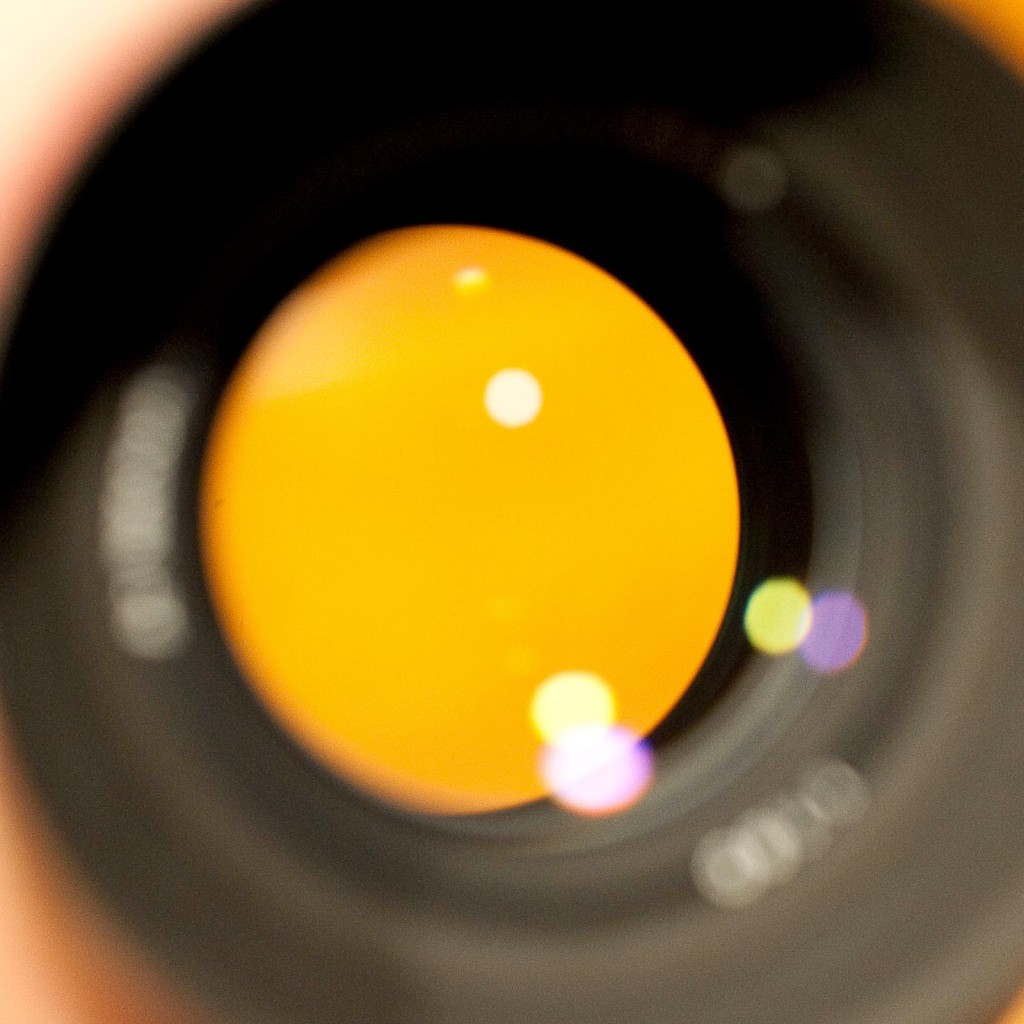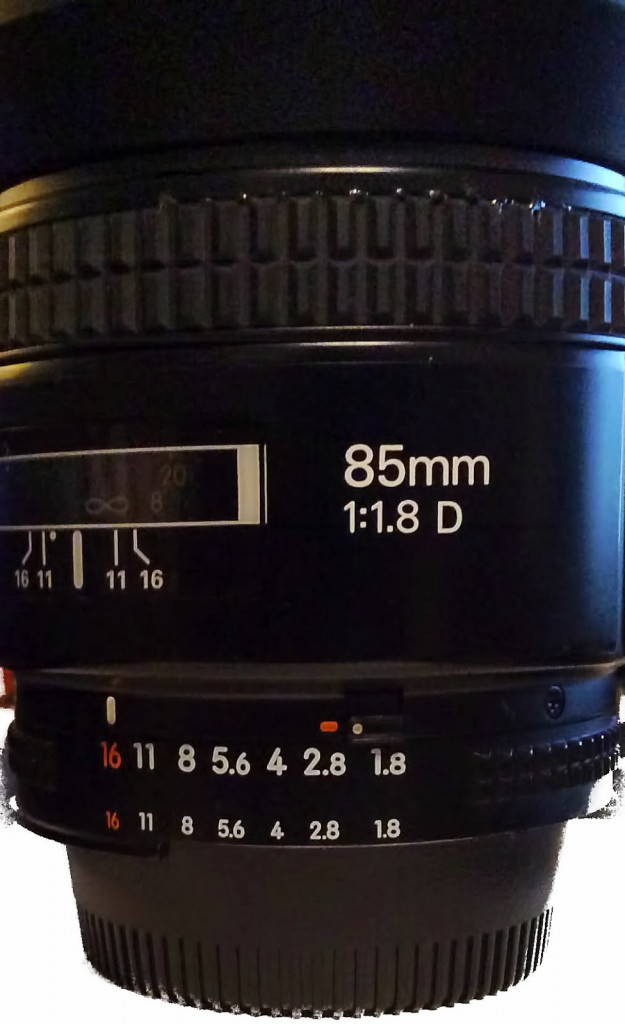 |
| Lens at f/16 |
 |
| Lens at f/1.8 |
Here I will try to explain the basics about the mysterious F number on your camera lens. The f stop of a lens is basically the size of the opening of the aperture of the lens; the higher or larger the F number the smaller the opening and the lower or smaller the F number the bigger the opening. Easy right? Bigger number means smaller opening equals less light gets to the sensor. Likewise smaller number means bigger opening equaling more light to the sensor. What else could you possibly need to know beyond that? PLENTY! Continue with me while I try to explain.
What you should know about f stop before purchasing a lens
The F number on the lens or maximum f number of a lens is often expressed as 1:X.X or F/X.X. Notice the picture of the lens below, it’s an 85mm 1:1.8. The 1:1.8, often expressed as f/1.8, is telling us the maximum aperture for this lens is 1.8. If we look at the f:stop scale we see that this lens can operate from f:1.8 to f:16. 1.8 would be considered wide open for this lens and 16 would be stopped down.
Maximum f stop
So why is the maximum f stop of a lens so critical to different types of photography? One, if you are planning on taking the best portrait pictures possible, you want the maximum f number or lower number. Generally in today’s popular DSLR cameras, f/1.4 is king. However, being king, this low f number will cost you royally. Currently the difference in price between the 1.8 lens pictured and the 85mm f/1.4 version is about $500 versus $1600; that’s $1100 for 1/2 stop of light or roughly 50% more light reaching the sensor. Is this really worth it? Lets see why it might be.
Depth of Field
What is depth of field? Depth of field is a fancy technical term for amount of area that is in focus. Field would refer to what is in focus and depth would refer to how deep that field reaches. If you have a deep depth of field that would mean that from near the camera to very far from the camera you have good focus. Shallow depth of field means there is a very small area front to back that remains in focus. The number one way to change the depth of field in photography is by using the f stop. The lower the f stop the shallower the depth of field. Conversely, the higher the f stop the deeper the depth of field. In the world of portrait photography, a shallow depth of field is normally more desirable. If you’re shooting a model outdoors, you want to isolate that model. Meaning the model is in perfect focus and everything in front and behind the model is blurred, effectively highlighting the model and thus giving a more desirable result. Without the low f stop you cannot do this effectively. If portraits are not your thing and price is a concern, go for the higher f number maximum aperture. But be careful, all things are not equal. If you go too cheap, you can get poor results no matter what the aperture. Its the same old thing: you get what you pay for. I have a general rule for what kinds of lenses to buy. If you are or want to be a serious pro, stick with prime lenses at f/1.4. If you are a serious amateur primes at f/1.8 are great. Amateurs and hobbyists are fine with zoom lenses at f/2.8 and higher. But remember, the glass makes the picture, not the camera. Most pros I know would prefer a sub prime camera body and great lens rather than the opposite.
When is it absolutely essential to adjust the aperture?
When you get into flash photography, and especially with off camera flash, the only real way to adjust exposure for the flash zone from the camera is by adjusting the aperture. Period. Adjusting the shutter speed will not affect the parts of the exposure where the flash has illuminated. The flash from a modern strobe lasts around 1/1000 of a second, so as long as the flash has gone off while the shutter is open, and we take into consideration the speed of light, we realize all the light will make it through to the sensor and will give the same exposure whether you have the shutter speed at 1/20 of a sec or 1/100 of a sec. The only areas that will change are the subject matters, which falls outside the flash coverage.
Bokeh (pronounced bokay)
Bokeh is a term photographers use for the out of focus areas of a photograph. A lens that gives a nice, soft, almost warm bubble like affect to the areas out of focus is considered a great lens. You can see the affects of bokeh especially good when pin points of light fall outside the depth of field when a low f stop is used. Generally the lower a lens f number the better the bokeh. Nothing draws attention better to your in focus subject than a dramatic drop off in depth of field and a soft bokeh in the background.
 |
| Example of nice bokeh with pin points of light |
Take away
•If you want the best lens you can find, get the lowest f stop lens you can afford. In a zoom lens that would be a f:2.8, and for prime lenses f:1.4 is king.
•Higher f stop equals higher depth of field. Conversely, lower f stop equals low depth of field
•Lower maximum f stop lenses are more expensive and desirable, especially for portrait work (Good bokeh).
I hope this explains in a simple way what f stop is and gives you some new ideas to try different techniques. I tried a very low technical approach to f stop. If you need more understanding of the formulas in play that determine f numbers, or you need to know the difference between f:2.8 and f:4 or why f:8 for most lenses is the sharpest or what sharp even means, continue looking. A good place to start would be wikipedia. I will try and come out with more articles like this one in the future. If you have an idea about this article or future articles, feel free to contact me and as always, thanks for stopping by.
